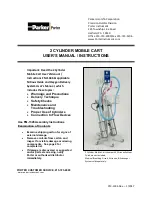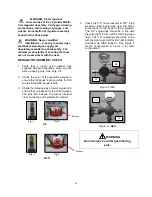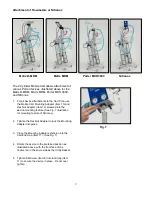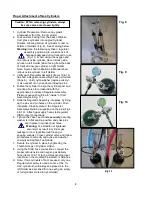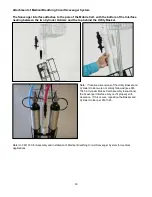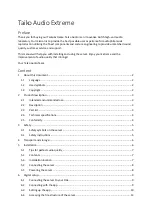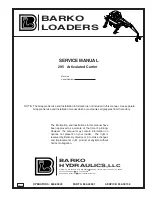
9
Cylinder Operation / Maintenance
Cylinder Pressure Readings:
Oxygen is a true
compressed gas, while in the cylinder, thus the
cylinder pressure gauge can be used to determine the
amount of gas remaining in the cylinder. For example,
2000 psi indicates full, 1000 psi indicates half full, etc.
Nitrous Oxide is a liquefied compressed gas that
vaporizes in the cylinder, thus the cylinder pressure
gauge cannot be used to determine the amount of gas
remaining in the cylinder until all liquid in the cylinder
vaporizes. While liquid remains in the cylinder, the
cylinder pressure gauge indicates the vapor pressure
which depends on and varies with the temperature of
the liquid. For example, at 68ºF, the vapor pressure is
about 750 psi; at 20ºF, it drops to about 400 psi; while
at 90ºF, it increases to about 1000 psi. After all the
liquid vaporizes, the pressure will decrease normally
as the gas is withdrawn, and the cylinder pressure
gauge can then be used to determine the amount of
gas remaining in the cylinder.
Cautions
Always turn on CYLINDER VALVES slowly and
fully.
NEVER ATTEMPT TO LOOSEN cylinder valve
packing nut. If valve stem is tight, return
cylinder to supplier.
Warning: Do not remove or alter gas
indexing pins
Good Practices: Cylinders with Mobile Cart
1. Two cylinders of N
2
O, or one cylinder of O
2
and
one cylinder of N
2
O are typically connected.
2. Minimize leak risks: Confirm Yoke Washers are in
place before replacing/mounting cylinders. Use
Porter #PA-1656-000 replacement washers
(once/yr. or as needed). Have spare washers.
3. Minimize leak risks: Tighten Tee Handle securely,
assuring washer is in flat sealing position and yoke
pins are in place in cylinder post holes.
4. Assure Mobile Cart is populated with cylinders of
N
2
O, or O
2
and N
2
O with adequate degree of fill
before starting any procedure.
5. Label cylinders
with a tag or sticker indicating “In-
Use” and “Full” (“Full” is reserve), if appropriate.
6. Use Cylinder W
rench to open the “In-Use”
cylinders. Verify wrench is attached to Cart (at
Utility Basket).
7. Cylinder
pressure
gauges
on
Regulator
Assemblies provide a visual indication of cylinder
status (see details on Cylinder Pressure
Readings)
8.
When “In-Use” cylinder is depleted, close valve,
bleed gas by slowly loosening Tee Handle, and
replace empty cylinder. Connect the Regulator
Assembly to
“Full” cylinder and open valve.
9.
When “In-Use” O
2
cylinder is depleted, the Oxygen
Fail Safe will stop N
2
O flow through Flowmeter or
Nitronox automatically.
10.
When “In-Use” N
2
O cylinder is depleted, the
Flowmeter or Nitronox will deliver 100% O
2.
11. After each use, turn off cylinder valves.
12. Method to use trapped nitrous oxide: Turning off
cylinder valves and turning Flowmeter or Nitronox
flow valves to off positions (or turning on/off valve
to off) will trap a small amount of nitrous gas in the
gas supply hose (assisted by check valve in
nitrous gas Regulator Assembly). Starting the next
procedure by turning on cylinder valves and
starting flow through the Flowmeter will use this
trapped gas (as opposed to venting the gas to the
environment).
Monthly Check
Flowmeter Leak Test.
Attach the gas supply Hoses
to a Flowmeter and turn the flow control knobs to the
OFF position and the ON / OFF switch to the OFF
position.
Turn cylinders ON. Pressurize the gas supply lines
and Mobile Cart Regulator Assemblies with cylinder
pressure. Turn cylinders OFF. Apply masking tape to
both gauge faces. Tap lightly on gauges and mark
gauge needle positions on the masking tape. There
should be little or no movement of the gauge needles
after 15 minutes.
Nitronox Leak Test:
Leave O2 supply on, close N2O
cylinder valve off, and apply tape only on N2O gauge
as above and watch for movement of gauge needle
after 15 minutes.
Summary of Contents for Porter Nitronox
Page 3: ...3...

